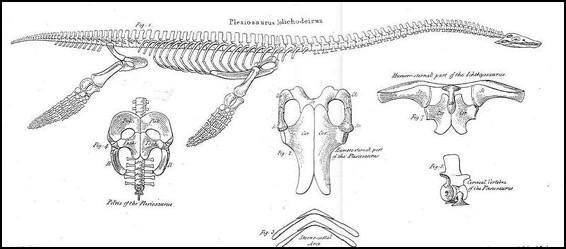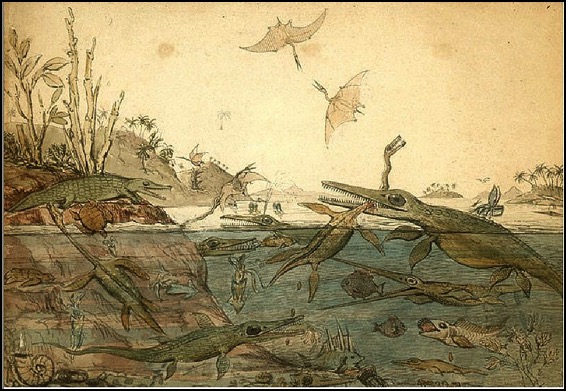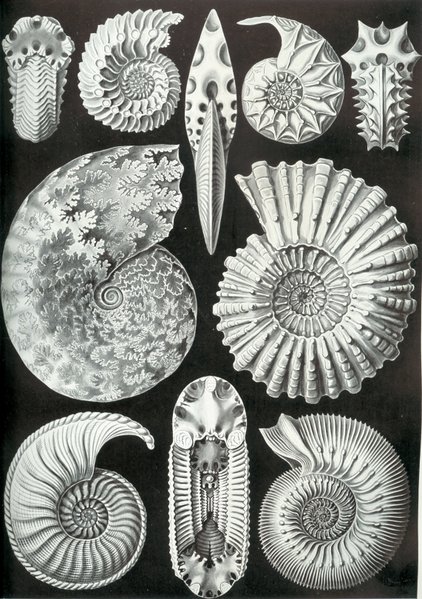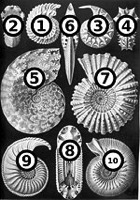A more ancient Dorset
// Jurassic
Time to pause and admire some of the beautiful and ornate illustrations inspired by the work of Mary Anning. The first is this illustration of the skeletal anatomy of a Plesiosaurus dolichodeirus from an 1824 paper by William Conybeare that described an almost complete fossilised plesiosaur that was found by Mary Anning in the preceding year.

This watercolour (below), painted by the English geologist Henry De la Beche in 1830 was based on the fossils Anning had collected and the complex food chain surmised from the coprolites of ichthyosaurs by Dr William Buckland. It was the first such drawing based on fossil evidence. When Anning faced financial difficulties, De la Beche commissioned a lithographic print of his watercolour, sold copies of it to colleagues and donated all the proceeds to the fossil collector. The original watercolour was called Duria Antiquior - a more ancient Dorset.

Another scientific description below - this time of Ammonites, but with an artitic twist from Ernst Haeckel’s 1904 book, Kunstformen der Natur (Artforms of Nature) - showing a few varieties of the highly successful family of prehistoric cephalopods. The ammonites were all wiped out 65 million years ago - at the same time as the extinction of the dinosaurs and 70% of all species - when a giant asteroid hit the earth. Biodiversity, however, was already under threat for many millions of years before the strike. Some scientists believe that a period of extreme volcanic activity may have extinguished many species even before the event.


1. Ammonites (Cardioceras) cordatus from the side
2. Ammonites (Cardioceras) cordatus from below
3. Ammonites (Schloenbachia) Coupei from the side
4. Ammonites (Schloenbachia) Coupei from below
5. Ammonites (Ptychites) opulentus from the side (outer shell layer removed)
6. Ammonites (Ptychites) opulentus from below
7. Ammonites (ornatus) mammillaris from the side
8. Ammonites (planulatus) cavernosus cross-section
9. Ammonites (amaltheus) rotula from the side
10. Ammonites (stephanoceras) Humphryi from the side
All images in public domain. Sourced from Wikimedia.

This watercolour (below), painted by the English geologist Henry De la Beche in 1830 was based on the fossils Anning had collected and the complex food chain surmised from the coprolites of ichthyosaurs by Dr William Buckland. It was the first such drawing based on fossil evidence. When Anning faced financial difficulties, De la Beche commissioned a lithographic print of his watercolour, sold copies of it to colleagues and donated all the proceeds to the fossil collector. The original watercolour was called Duria Antiquior - a more ancient Dorset.

Another scientific description below - this time of Ammonites, but with an artitic twist from Ernst Haeckel’s 1904 book, Kunstformen der Natur (Artforms of Nature) - showing a few varieties of the highly successful family of prehistoric cephalopods. The ammonites were all wiped out 65 million years ago - at the same time as the extinction of the dinosaurs and 70% of all species - when a giant asteroid hit the earth. Biodiversity, however, was already under threat for many millions of years before the strike. Some scientists believe that a period of extreme volcanic activity may have extinguished many species even before the event.


1. Ammonites (Cardioceras) cordatus from the side
2. Ammonites (Cardioceras) cordatus from below
3. Ammonites (Schloenbachia) Coupei from the side
4. Ammonites (Schloenbachia) Coupei from below
5. Ammonites (Ptychites) opulentus from the side (outer shell layer removed)
6. Ammonites (Ptychites) opulentus from below
7. Ammonites (ornatus) mammillaris from the side
8. Ammonites (planulatus) cavernosus cross-section
9. Ammonites (amaltheus) rotula from the side
10. Ammonites (stephanoceras) Humphryi from the side
All images in public domain. Sourced from Wikimedia.
